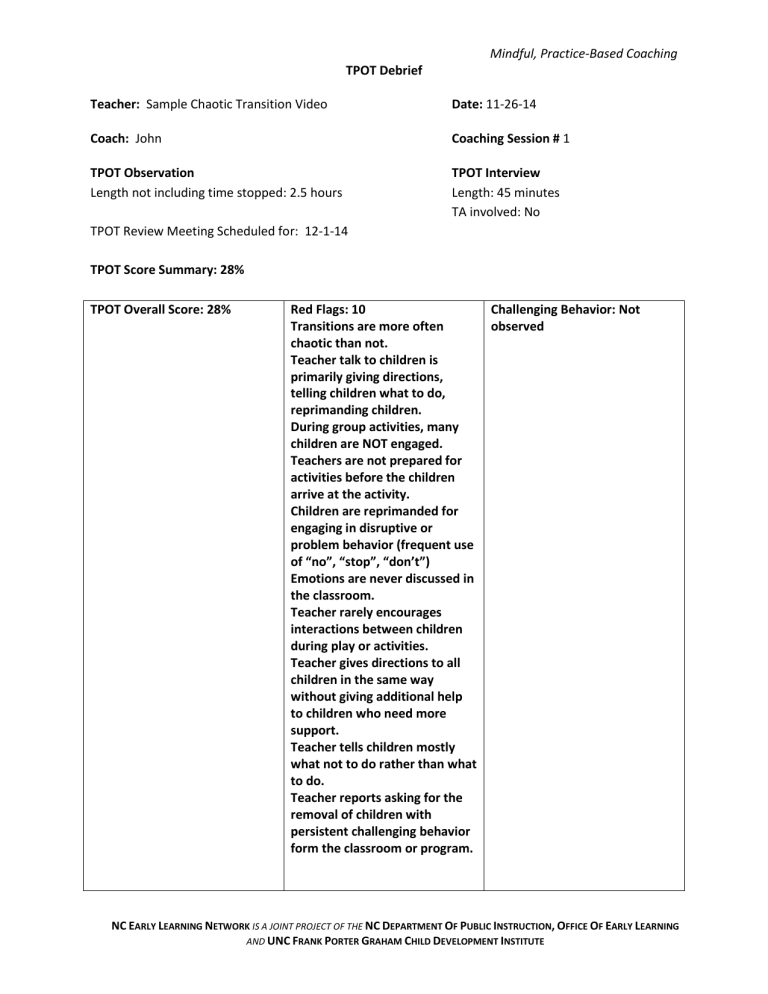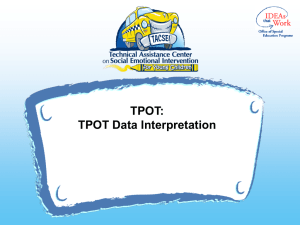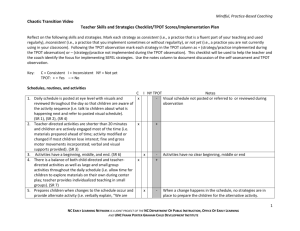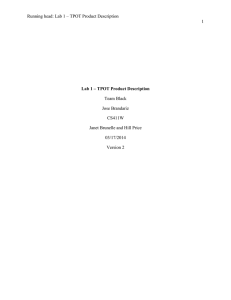Coaches TPOT Debrief for Chaotic Transition

Mindful, Practice-Based Coaching
Teacher: Sample Chaotic Transition Video
TPOT Debrief
Date: 11-26-14
Coaching Session # 1 Coach: John
TPOT Observation
Length not including time stopped: 2.5 hours
TPOT Review Meeting Scheduled for: 12-1-14
TPOT Score Summary: 28%
TPOT Overall Score: 28%
TPOT Interview
Length: 45 minutes
TA involved: No
Red Flags: 10
Transitions are more often chaotic than not.
Teacher talk to children is primarily giving directions, telling children what to do, reprimanding children.
During group activities, many children are NOT engaged.
Teachers are not prepared for activities before the children arrive at the activity.
Children are reprimanded for engaging in disruptive or problem behavior (frequent use of “no”, “stop”, “don’t”)
Emotions are never discussed in the classroom.
Teacher rarely encourages interactions between children during play or activities.
Teacher gives directions to all children in the same way without giving additional help to children who need more support.
Teacher tells children mostly what not to do rather than what to do.
Teacher reports asking for the removal of children with persistent challenging behavior form the classroom or program.
Challenging Behavior: Not observed
NC E ARLY L EARNING N ETWORK IS A JOINT PROJECT OF THE NC D EPARTMENT O F P UBLIC I NSTRUCTION , O FFICE O F E ARLY L EARNING
AND UNC F RANK P ORTER G RAHAM C HILD D EVELOPMENT I NSTITUTE
Mindful, Practice-Based Coaching
TPOT Debrief
TPOT Scores: TPOT items to work toward:
Schedules
Transitions
4 of
10 40 % SR 2 Posted schedule is at children’s eye level and includes visual representation of daily activities.
SR5 Teacher reviews the posted schedule with children AND refers to it throughout the observation.
SR 6 Teacher structures activities so that there is a clear beginning, middle AND end.
SR 8 If needed, the teacher prepares children when changes are going to occur within the posted schedule.
SR 9 Teacher only continues with a specific teacher-directed activity when the majority of children are actively engaged AND interested.
SR 10 Children who need extra support are prepared for activities using an activity schedule OR individualized cues at the beginning of the activities.
0 of
8 0 % TR1 Teacher supports children’s transitions.
TR 2 Whole-class warnings are provided prior to the majority of transitions.
TR 3 Teacher has transition strategies that ensure children are actively engaged in the transition.
TR 4 Teacher explicitly teachers children steps AND expectations of transitions.
TR 5 Teacher provides positive, descriptive feedback to children who engage in the transition appropriately.
TR 6 Instruction to begin the transition is provided to a child in an individualized way.
TR 7 Teacher effectively guides individual children who need extra support during transitions.
TR 8 During transitions, the majority of children is actively engaged, including children who are waiting for the next activity.
Conversations 2 of
10 20 % SC 1 Teacher acknowledges children’s communication to him/her
SC 3 Teacher has brief conversations with children
SC 6 Teacher’s tone in conversations with children is generally positive, calm, AND supportive.
SC 6 Teacher responds to children’s comments AND ideas by asking questions AND making comments.
SC 7 Teacher often uses positive descriptive feedback for children’s skills, behaviors, and activities.
SC 8 Teacher joins in children’s play to expand their interactions and ideas with other children.
SC 9 Teacher has extended comfortable AND positive conversations with children during routines and activities about their interests and ideas.
SC 10 Teacher uses alternative strategies when communicating with children who are nonverbal, language delayed, or dual language learners.
NC E ARLY L EARNING N ETWORK IS A JOINT PROJECT OF THE NC D EPARTMENT O F P UBLIC I NSTRUCTION , O FFICE O F E ARLY L EARNING
AND UNC F RANK P ORTER G RAHAM C HILD D EVELOPMENT I NSTITUTE
Engagement
Directions
Teaming
Mindful, Practice-Based Coaching
TPOT Debrief
2 of
9 22 % ENG 2 Teacher provides developmentally appropriate activities that will support the engagement of almost all of the class.
ENG 3 Teacher communicates with children on eye level almost all the time.
ENG 4 Teacher directed large-group activities are structured so that children have opportunities to be actively engaged almost all the time.
ENG 5 Teacher assists individual children in selecting center or other child-directed activities and becoming actively engaged.
0 of
7 0 %
ENG 7 Teacher frequently comments positively on children who are engaged in activities.
ENG 8 Teacher assists individual children who are exhibiting challenging behavior within an activity become actively engaged.
ENG 9 Teacher mo9difies instruction OR activity when children lose interest in large AND small-group activities.
PD 1 Teacher uses directions that are simple, short, AND specific.
PD 2 Teacher uses directions that tell children what to do rather than what not to do.
PD 3 Teacher consistently provides positive descriptive feedback to children who follow directions.
PD 4 Teacher describes the activity expectations to children prior to OR at the beginning of an activity.
PD 5 Teacher redirects children who are withdrawn, distracted, OR off task to more productive activities.
PD 6 Teacher checks in with children to make sure they understand directions.
PD 7 Teacher individualizes directions for children who need more support (additional prompt, nonverbal prompt along with verbal directions, picture prompts)
2 of
9 22 % CT 1 All adults are engaged with children during classroom activities OR routines.
CT 3 The classroom runs smoothly with all adults appearing to know what they are supposed to be doing throughout the observation.
CT 4 All adults who enter the classroom engage with children including related services personnel
AND administrators.
CT 6 There is evidence that roles are shared among team members during the observation.
CT 7 All adults provide instruction at some point during the observation.
CT 8 Adults give positive feedback to each other about something that is going well with a child OR in the classroom.
CT 9 Children initiate positive interactions with all calssroo9m staff at some point during the observation.
NC E ARLY L EARNING N ETWORK IS A JOINT PROJECT OF THE NC D EPARTMENT O F P UBLIC I NSTRUCTION , O FFICE O F E ARLY L EARNING
AND UNC F RANK P ORTER G RAHAM C HILD D EVELOPMENT I NSTITUTE
Mindful, Practice-Based Coaching
TPOT Debrief
Behavior
Expectations
Social-Emotional
Competencies
1 of
7 14 % TBE 2 Posted behavior expectations or rules are reviewed with children during large OR small group activities.
TBE 3 Children are reminded or posted behavior expectations o9r rules throughout the observation.
TBE 4 Teacher provides instruction OR reminders on posted behavior expectations or rules to individual children, during paly or within small-group activities.
TBE 5 Teacher comments on appropriate child behavior, linking the behavior to the posted classroom rules or expectations.
TBE 6 Throughout the observation, the teacher provides specific positive feedback to children on meeting posted behavior expectations or rules.
TBE 7 Teacher facilitates discussion where children are Involved in critically thinking about posted behavior expectations or rules AND their importance.
1 of
8 13 % TSC 1 Teacher uses naturally occurring opportunities across the day to teach social skills OR emotional competencies.
TSC 3 Teacher uses a variety of strategies to help children learn the concept associated with specific skills (role play, discussion. describing observations of children in the classroom who demonstrated the skill).
TSC 4 Teacher uses small- OR large group settings to teach social skills OR emotional competencies (friendship skills, problem solving, emotional literacy)
TSC 5 Teacher models expected social skills AND emotional competencies while describing his/her behavior.
TSC 6 Teacher comments positively AND descriptively on children who are using social skills AND expressing their emotions in appropriate ways.
TSC 7 Teacher helps children reflect on their use of social skills OR emotional competencies either individually OR in groups.
TSC 8 Teacher individualizes instruction of social skills OR emotions competencies (one-on-one instruction as needed, different prompting strategies) based on children’s develop0mental needs.
Procedures OR materials vary across children.
Friendship Skills 3 of
9 33 % FR 2 Teacher comments positively And descriptively on children who are working together, helping each other or engaging in other friendship behaviors.
FR 3 Teacher uses a variety of strategies AND materials
(discussions, puppets, books) in small- OR large group activities to teach friendships skills (helping others, taking turns, organizing play).
FR 5 Teacher explicitly teaches OR prompts individual children how to initiate AND respond to their peers.
NC E ARLY L EARNING N ETWORK IS A JOINT PROJECT OF THE NC D EPARTMENT O F P UBLIC I NSTRUCTION , O FFICE O F E ARLY L EARNING
AND UNC F RANK P ORTER G RAHAM C HILD D EVELOPMENT I NSTITUTE
Mindful, Practice-Based Coaching
TPOT Debrief
Emotions
FR 6 Teacher provides individualized assistance to help children maintain interactions (multiple interaction exchanges) with peers.
FR 7 Teacher uses a variety of strategies (peer buddies, structuring activities) to support peers I helping their friends learn AND practice social skills.
FR 8 Teacher models friendship skills in interactions with children or other adults.
FR 9 Teacher supports children in reflecting on interactions with their peers with children doing most of the talking.
2 of
8 25 % TEE 3 Teacher uses a variety of strategies to teach children how to recognize emotions in themselves and others.
TEE 4 Teacher validates children’s emotions by labeling them AND helping children talk about their emotions.
TEE 5 Teacher provides children with strategies to use when they are angry to calm down.
TEE 6 Teacher models or labels own emotions OR appropriate ways to express emotions.
TEE 7 Teacher uses a variety of strategies to teach children how to respond to other’s emotions.
TEE 8 Teacher individualizes instruction on emotions based on children’s developmental needs. Procedures and materials vary across children.
Problem Solving 2 of
9 22 % TPS 1 Teacher supports children as they work through the problem-solving process in naturally occurring situations.
TPS 2 Teacher engages children in generating solutions to common
Challenging
Behavior classroom problems.
TPS 3 Teacher explicitly teachers problem-solving steps using visuals.
TPS 4 Teacher provides visual reminders about problem-solving steps or possible solutions,
TPS 5 Teacher notes problem situations AND uses those as examples during group situations to talk about how to problem solve.
TPS 6 Teacher comments on AND recognizes children who have been “good problem solvers”.
TPS 7 Teacher helps children reflect on their own use of problem solving.
TPS 8 Teacher individualizes instruction on problem solving based on children’s individual needs.
TPS 9 Teacher uses problem solving in interactions with children
AND models problem-solving steps.
2 of
5 40 % PCB 3 Teacher describes participating in the development of a behavior support plan by contributing ideas for strategies to be included on the plan.
PCB 4 Teacher describes imp0lementing individualized behavio9r support plan strategies.
NC E ARLY L EARNING N ETWORK IS A JOINT PROJECT OF THE NC D EPARTMENT O F P UBLIC I NSTRUCTION , O FFICE O F E ARLY L EARNING
AND UNC F RANK P ORTER G RAHAM C HILD D EVELOPMENT I NSTITUTE
Mindful, Practice-Based Coaching
TPOT Debrief
PCB 5 Teacher describes monitoring child progress by collecting data.
Family
Involvement
Family Social-
Emotional
Support
8 of
8 100 %
3 of
7 43 % INF 3 Teacher describes giving families practical strategies that they can use during every day routines and activities to support their children’s social emotional development AND prosocial behavior.
INF 4 Teacher describes working with families to develop strategies that families can use at home to address challenging behaviors.
INF 5 Teacher indicates that when there is a concern about a child’s challenging behavior OR social emotional development, the teacher works with families to collect information on the behavior to determine if there is a need for more intensive support or planning.
INF 7 Teacher describes working with families to develop strategies that families can use at home to address their concerns about their child’s social emotional development.
What went well during the TPOT observation?
Family involvement and communication seem to be strengths for you. During large and small group some of the children were engaged. Activities were developmentally appropriate for the children. Rules and schedules were posted.
What practices do you need to develop more fully to be successful?
The children seemed to be wild during transition to outside play. They had more difficulty today than usual. Everyone was out of his/her place and pushing and shoving to get in line, then when one was in line the rest were out of line. It seemed like a mess and I noticed that I was beginning to get louder and more upset because it was taking so long to line up. I don’t know what was wrong with the children today. I would like to have smoother transitions during the day. I just don’t have enough hands to hold all the children’s hands to make sure they are ready to go outside.
Of the items you listed above, what practices would you like to concentrate on first?
I would like for the children to be more independent in transitions so we can have a more efficient transition to outside time and not waste so much of our time lining up.
Focus of Observation (include TPOT items teacher is working toward):
Support children’s transitions by providing transition cues (verbal and physical) and by reviewing steps verbally (TR1). Utilize transition strategies that ensure children are actively engaged in the transition
(TR 3).
Next Steps for Teacher:
Teacher will choose and implement one visual plus verbal strategy for transition during dismissal to centers, and outside play and back to group. Provide clear verbal directions with the visual.
NC E ARLY L EARNING N ETWORK IS A JOINT PROJECT OF THE NC D EPARTMENT O F P UBLIC I NSTRUCTION , O FFICE O F E ARLY L EARNING
AND UNC F RANK P ORTER G RAHAM C HILD D EVELOPMENT I NSTITUTE
Mindful, Practice-Based Coaching
TPOT Debrief
Next Steps for Coach: The coach will model use of the visual and verbal strategy for transition during group time and dismissal to outdoor time. The coach will provide visual prompts for the teacher. The coach will also provide videos for the teacher to watch on well planned transitions. Teacher and coach will meet to discuss what worked well in the videos and if the teacher saw a strategy she might like to try.
Next Observation:
Date/Time of observation: 12-1-14 from 10:00-11:45
Date/Time of debrief: 12-1-14 from 1:00-1:45
Adapted from Wake County Preschool STAR Project, TPOT Summary Sheet
NC E ARLY L EARNING N ETWORK IS A JOINT PROJECT OF THE NC D EPARTMENT O F P UBLIC I NSTRUCTION , O FFICE O F E ARLY L EARNING
AND UNC F RANK P ORTER G RAHAM C HILD D EVELOPMENT I NSTITUTE











